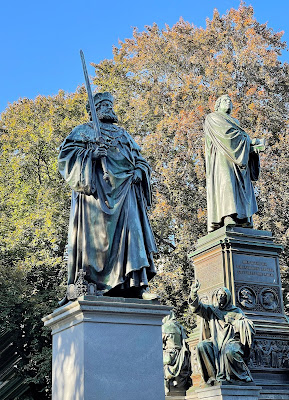
|
| Indeed, my spellchecker keeps correcting me: Worms are a city on the Rhine (seen on Facebook) |

|
|
The decisive scene painted by Anton von Werner in 1877 reproduced on a wall on the way to the exhibition |
This was based on reciprocity. Luther judged young Charles, "He sat like an
innocent little lamb between sows and dogs."
As a result of this second hearing - you may read the full story in German - Luther stayed not only banned by the pope but became outlawed by an Imperial Edict. That meant everybody in the Empire could capture Martin and even kill him without punishment.
An exhibition, "Hier stehe ich. Gewissen und Protest – 1521 bis 2021 (Here I Stand. Conscience and Protest - 1521 to 2021)" at the Museum in Worms's Andreasstift commemorates the 500th anniversary of the event regarded as the trigger for the schism in the Church.
With the Reformer in focus, the exhibition concentrates on the question of conscience. Other personalities are commemorated, like Michael Servetus, Wiliam the Silent, Anne Hutchinson, Moses Mendelsohn, Georg Büchner, Sophie Scholl, Martin Luther King Jr., and Nelson Mandela.
Worms has the largest Reformation monument in the world.
Emperor Charles V had promised Luther's sovereign
Frederick the Wise, Elector of Saxony, to grant free passage to Worms to the
Doctor from Wittenberg. In his politely worded citation, the Emperor wrote that at the Imperial Diet, learned and highly respectable persons
shall interrogate him.
Luther received the imperial invitation on March 29, 1521, and was
warned. Hus was also promised safe conduct, but he was burned at the
Council of Constance in 1415.
Savonarola had suffered the same fate in Florence 23 years earlier.
Brother Martinus, however, threw all misgivings to the wind, "Let them make a fire that reaches to the clouds between Worms and Wittenberg. I will kick the Behemoth* in his mouth between the teeth and confess Christ."
*Hippopotamus-like animal in the Book Job 40:15
Throughout German history, Luther was instrumentalized politically.
Luther was abused at the beginning of the Second Reich on the occasion of
the inauguration of the Hermannsdenkmal. The monument glorifies the fact that
the Germanic Prince Arminius had beaten the invading Romans at the
Teutoburger woods in 9 AD.
As Arminius stood against the Roman invasion, Luther stood against the Pope in Rome. Remember: the inauguration of this symbol of conservative German nationalism took place at the time of the Kirchenkampf, Bismarck's struggle against the Catholic Church and its Party, the Zentrum (the Catholic Center Party).
On October 31, 1917, the German Protestant Church Committee had the following proclamation read from the pulpits, "Just as our fathers in the faith were worthy of the heroism of the Reformer, so we also want to show ourselves worthy of our lost sons and brothers and confess: Our God is a stronghold*; the Reich must remain with us."
*Ein feste Burg ist unser Gott
Luther's 450th birthday in 1933 fell together with the
Machtergreifung (takeover) of the Nazis, an occasion to make Luther
one of their own.
As a result of this second hearing - you may read the full story in German - Luther stayed not only banned by the pope but became outlawed by an Imperial Edict. That meant everybody in the Empire could capture Martin and even kill him without punishment.
An exhibition, "Hier stehe ich. Gewissen und Protest – 1521 bis 2021 (Here I Stand. Conscience and Protest - 1521 to 2021)" at the Museum in Worms's Andreasstift commemorates the 500th anniversary of the event regarded as the trigger for the schism in the Church.

|
| The entrance to the exhibition |

|
| Luther is all over the place. |
Taking photos at the exhibition was not allowed, so I will present some
less-known facts about Luther and his Reformation.

|
|
The vast Lutherdenkmal from a distance. It places Luther in the center but shows his supporters and precursors too. |

|
|
The monument was conceived and partially executed by Ernst Friedrich August Rietschel. Luther and his wife Käthe take the Lord's supper. Luther gives the chalice to his wife, Käthe. The Reformer's wedding. |

|
| The Elector of Saxony protects Brother Martin well. |

|
| Jan Hus |

|
| Girolamo Savonarola |
Brother Martinus, however, threw all misgivings to the wind, "Let them make a fire that reaches to the clouds between Worms and Wittenberg. I will kick the Behemoth* in his mouth between the teeth and confess Christ."
*Hippopotamus-like animal in the Book Job 40:15
When Luther entered Worms on a horse-drawn cart Luther on the morning of April 16, trumpets sounded from the cathedral's tower as if the people
were expecting the new Messiah. When he, accompanied by a cavalcade of
Saxon nobles, finally arrived at his domicile, the city's Johanniterhof,
he said, "Hus was burned, but not the truth with him. I want to go in,
even if as many devils are aiming at me as there are tiles on the
roofs."
Throughout German history, Luther was instrumentalized politically.

|
| Against Rome in the past and now |
As Arminius stood against the Roman invasion, Luther stood against the Pope in Rome. Remember: the inauguration of this symbol of conservative German nationalism took place at the time of the Kirchenkampf, Bismarck's struggle against the Catholic Church and its Party, the Zentrum (the Catholic Center Party).
On October 31, 1917, the German Protestant Church Committee had the following proclamation read from the pulpits, "Just as our fathers in the faith were worthy of the heroism of the Reformer, so we also want to show ourselves worthy of our lost sons and brothers and confess: Our God is a stronghold*; the Reich must remain with us."
*Ein feste Burg ist unser Gott

|
|
Hitler's Struggle and Luther's Teaching, are the German People's Good Defence |
*


No comments:
Post a Comment